'body of the message'
Ortsbegehung No. 4
NBK Berlin 1998
curated by Inke Arns
Inke Arns
(works with a + are not part of the actual exhibition but constitute its thematical framework)
However disparate the new
media and artistic/aesthetic strategies deployed in the body of the
message exhibition, the works on display by Sandra Becker, Daniel Pflumm
and Joachim Blank & Karl Heinz Jeron are linked by a common interest
in the radical re-structuring/re-invention of public space currently in
progress. Although invisible to the human eye, the process has far-reaching
implications. Every urban space, writes the French philosopher Michel de
Certeau in The Practice of Everyday Life, has two distinctive basic
characteristics, the first being the static plan of the so-called "Concept-city"
given material form in the built order. Yet any urban fabric is at the
same time made up of fluid structures and streams, such as traffic and
information. While these streams follow the material structures 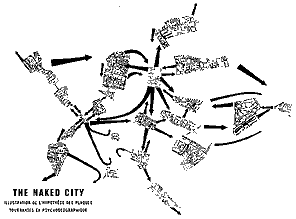 of
the built city, they are equally capable of flowing in the opposite direction,
and in doing so of altering the static location. "A migrational, or metaphorical,
city thus slips into the clear text of the planned and readable city."
(2) One is tempted to expand this statement by adding
that the contrast between the static and fluid city is not absolute, but
only describes aggregate states of urban space flowing at different velocities:
there are fast, and less fast, streams of architectures, bodies, merchandise,
signs, and information. The work of Becker, Pflumm, and Blank & Jeron
is concerned with those new types of media structures that, as nomadic
and ephemeral extensions, graft themselves onto our public spaces, and
qualitatively change them – in a political sense, too. (3)
The artists strive to make visible the unseen motion in these new urban
spaces of transit, to visualize specific streams of signs, merchandise,
bodies and information – those elements, in other words, that are in transit
through these new territories. In short: their work is about the subject
alluded to by the exhibition’s title: "body of the message". The term comes
from the field of e-mail communications, where it designates that part
of an electronic message addressed to a human reader as opposed to the
program code directed to the machine. (4)
of
the built city, they are equally capable of flowing in the opposite direction,
and in doing so of altering the static location. "A migrational, or metaphorical,
city thus slips into the clear text of the planned and readable city."
(2) One is tempted to expand this statement by adding
that the contrast between the static and fluid city is not absolute, but
only describes aggregate states of urban space flowing at different velocities:
there are fast, and less fast, streams of architectures, bodies, merchandise,
signs, and information. The work of Becker, Pflumm, and Blank & Jeron
is concerned with those new types of media structures that, as nomadic
and ephemeral extensions, graft themselves onto our public spaces, and
qualitatively change them – in a political sense, too. (3)
The artists strive to make visible the unseen motion in these new urban
spaces of transit, to visualize specific streams of signs, merchandise,
bodies and information – those elements, in other words, that are in transit
through these new territories. In short: their work is about the subject
alluded to by the exhibition’s title: "body of the message". The term comes
from the field of e-mail communications, where it designates that part
of an electronic message addressed to a human reader as opposed to the
program code directed to the machine. (4)
To investigate the role played
by "message bodies" in these new spaces and, above all, define what they
are in the first place, the concepts of "body", "message", "writing", "text",
and "reading" can serve as cartographic cornerstones. In Sandra Becker’s
works it is the "real" human bodies of passers-by which emit "messages"
or communications; ones which by adhering to an urban text (can) consciously
write themselves into it, but at the same time leave behind traces of which
they are unaware. The body in Daniel Pflumm’s work no longer signifies
the individual person, but a transnational concern, its corporate identity
recognizable only by a logo. The (signifying) body, metalinguistic and
globally readable, is becoming a message that is sufficient unto itself.
On the Internet, by contrast, the medium employed by Blank & Jeron,
it is becoming increasingly impossible to distinguish between messages
emerging from the (human) body and (machine) code: the existence of a body
independent of the transmitter is being more and more imputed to the message.
Bio-physicality has become questionable, the status of authenticity is
more vulnerable, ambivalent. Becker, Pflumm, and Blank & Jeron choose
approaches which scrutinize various aspects of "message bodies" in contemporary
mediatized urban spaces: the movements by people in these spaces; the fluctuation
of signifying bodies, as well as the increasing digitization (i.e. the
radical reduction) of bodies that, until now analog, are caught up in a
process of transition into the realm of information.

Sandra Becker, Persona
Grata 1-4
The "message bodies" shown to us by Sandra Becker are obviously "real": human bodies in motion, rushing in their hundreds along subway passages, standing on escalators, waiting – the artist calls this "poetics of waiting" -- for time to pass in "transit rooms", those "cathedrals of the return journey". (5) The 19th-century intoxication with new possibilities of acceleration has meant ever since that people can be "in velocity" – "similar to the way we are in China, another region, another continent, that we claim to know." (6) Sandra Becker is interested in the practitioners of the city, the passers-by in New York, Berlin, Moscow and Tokyo "whose bodies follow the thicks and thins of an urban "text" they write without being able to read it." (7)
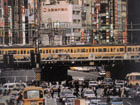

+ Downtown Tokyo
+ Rush hour in a Japanese manga
These bodies leave behind traces (via surveillance cameras, credit cards) without their being aware of it; admittedly, they cannot read the text they write, but it is read by others. The text first becomes legible when viewed from a panoptical centre. Although Sandra Becker is citing in her work the aesthetic of public surveillance cameras, she immediately subverts the normative distanced totality of this view by adopting a number of standpoints. Her camera tracks down fragments of fictional stories arising in places of transit, on the journey between here and there. Walking in the city makes places become spaces that "make some parts of the city disappear and exaggerate others, distorting it, fragmenting it, and diverting it from its immobile order" (8). It is de Certeau’s metaphorical or migrational city that one encounters in Sandra Becker’s works.
 +
Technologies to the
People, Street Access Machine
+
Technologies to the
People, Street Access Machine
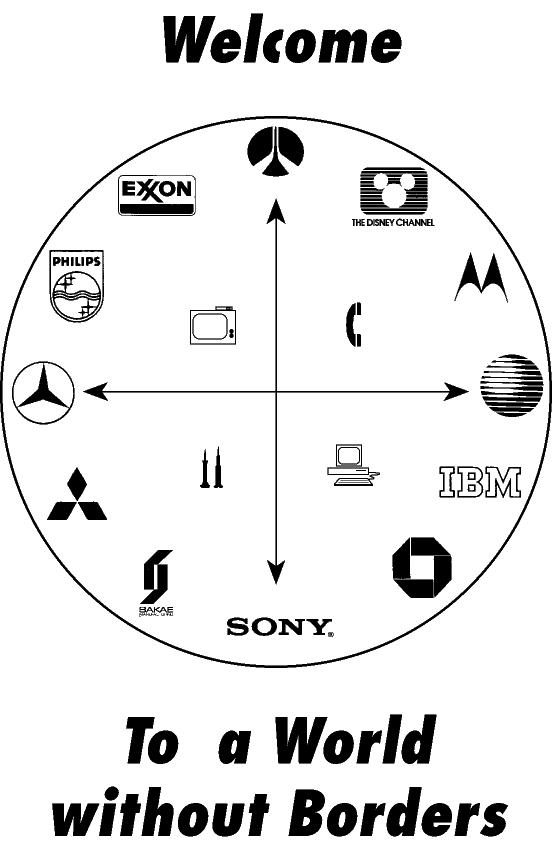 +
Critical Art Ensemble, in: The Electronic Disturbance,
NY, 1994
+
Critical Art Ensemble, in: The Electronic Disturbance,
NY, 1994
In Daniel Pflumm’s work the
"message bodies" are reduced to the "glossy veneer" of pure surfaces: colourful
logos, corporate identities and brandnames frenetically alternate with
each other. These "message bodies" point to supra-individual, transnational
corporations, geographically distributed enterprises making products sold
worldwide in a globalized economy, and therefore requiring images that
are globally recognizable; these are control characters addressed to global
recipients. The control characters pass through the urban realm and collective
global subconscious, indicating in passing the velocity of an almost instantaneous 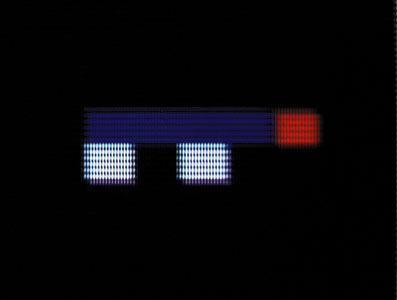 worldwide
presence. Pflumm detaches from their context (TV or Internet) the labels,
re-models them on the computer, breaks them down into their structural
elements, and sets these constituents spinning in an endless loop. In anti-logo
video (1997), he manually eliminates lettering of any kind, or electronically
screens it until it is illegible. In SILENCER (1997) he achieves
a similar result by means of extremely blurred videotaped images of neon
advertisements flashing on and off in urban environments. Pflumm also combines
found material with labels (sometimes they are appropriated corporate logos)
designed for his own projects: in his
worldwide
presence. Pflumm detaches from their context (TV or Internet) the labels,
re-models them on the computer, breaks them down into their structural
elements, and sets these constituents spinning in an endless loop. In anti-logo
video (1997), he manually eliminates lettering of any kind, or electronically
screens it until it is illegible. In SILENCER (1997) he achieves
a similar result by means of extremely blurred videotaped images of neon
advertisements flashing on and off in urban environments. Pflumm also combines
found material with labels (sometimes they are appropriated corporate logos)
designed for his own projects: in his  videos,
the boundaries between Elektro (Club, 1992-94), AT&T,
Panasonic (Club, 1995-97), Esso, PAN AM, WMF (Club),
and Microsoft are fluid. The videos, with a repetition frequency
deviating from that of normal advertisements, break through normal perceptive
patterns. On the other hand, "the monotony of this sequence of images [...]
reveals the symbolic character of visual forms apparently taped only by
coincidence." (9) At the same time, there is something
especially fragile and transient about those logos the artist "censored"
or "de-cored" (10) – stripped of all text and reduced
to their minimal graphic form. Daniel Pflumm’s videos are archives recording
the rapid transformations in advertising and media aesthetics.
videos,
the boundaries between Elektro (Club, 1992-94), AT&T,
Panasonic (Club, 1995-97), Esso, PAN AM, WMF (Club),
and Microsoft are fluid. The videos, with a repetition frequency
deviating from that of normal advertisements, break through normal perceptive
patterns. On the other hand, "the monotony of this sequence of images [...]
reveals the symbolic character of visual forms apparently taped only by
coincidence." (9) At the same time, there is something
especially fragile and transient about those logos the artist "censored"
or "de-cored" (10) – stripped of all text and reduced
to their minimal graphic form. Daniel Pflumm’s videos are archives recording
the rapid transformations in advertising and media aesthetics.

+ makrolab <http://makrolab.ljudmila.org>
scanning the skies and mapping data flows over Lutterberg during documenta
X, Kassel 1997
Today, information is available
in abundance as the raw material for art. Working under the project name
sero.org (11), Joachim Blank & Karl Heinz
Jeron have since 1997 been addressing the concept of information and the
problems of information smog (i-smog) in the so-called information society.
Especially since 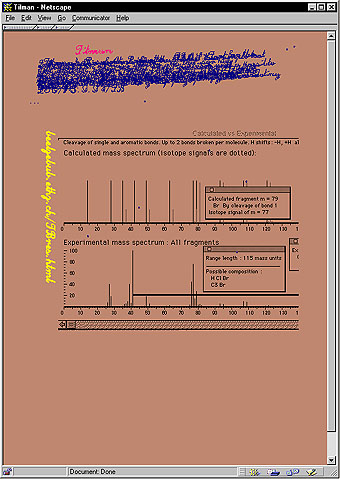 the
onset of mass usage of the Internet, the "information society" has been
facing garbage problems caused by the surplus of data. Blank & Jeron
therefore began to develop information recycling (i-recycling) concepts;
perfidiously enough, their ideas do not tackle the problem of eliminating
the cause of the bothersome information overload, but increase the bulk
of existing data. Their Internet projects without_addresses (12)
(1997) and DUMP YOUR
the
onset of mass usage of the Internet, the "information society" has been
facing garbage problems caused by the surplus of data. Blank & Jeron
therefore began to develop information recycling (i-recycling) concepts;
perfidiously enough, their ideas do not tackle the problem of eliminating
the cause of the bothersome information overload, but increase the bulk
of existing data. Their Internet projects without_addresses (12)
(1997) and DUMP YOUR 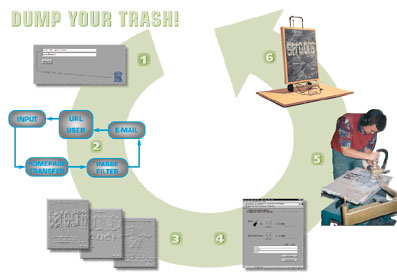 TRASH!
(13) (1998) ironically blur the narrow precipice separating
information from disinformation, and question the "true (14)
value of information in our society": while the simulated/dysfunctional
search engine without_addresses makes accessible as handwritten,
illegible documents the data bodies and traces (leading e.g. to a human
being) on the Internet, DUMP YOUR TRASH! allows the user to turn
inherently ephemeral Web sites into marble slabs inscribed with a stonemason’s
chisel.
TRASH!
(13) (1998) ironically blur the narrow precipice separating
information from disinformation, and question the "true (14)
value of information in our society": while the simulated/dysfunctional
search engine without_addresses makes accessible as handwritten,
illegible documents the data bodies and traces (leading e.g. to a human
being) on the Internet, DUMP YOUR TRASH! allows the user to turn
inherently ephemeral Web sites into marble slabs inscribed with a stonemason’s
chisel.
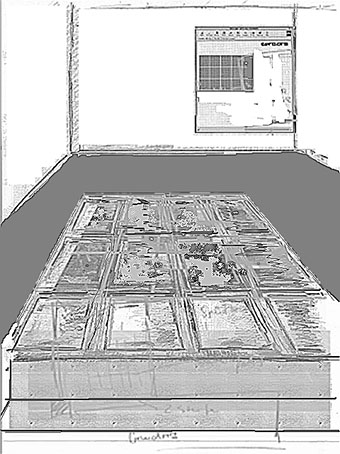 The
latter process is inverted by Scanner++ (1998): because it is a
"walk-on" scanner, "real" bodies enter the virtual realm, their physical
mass becomes information, "traces of bodies"; compatible, globally retrievable
and archivable <http://sero.org>. The principle of the search engine,
actually an industrious, invisible software program scouring the Internet
for information, is here lent almost obscenely material form as a symptomatic
object now superimposed over real space, which it proceeds to systematically
scan. Absurd, this machine – while its size alone embodies the constant
growth in information consumption, it simultaneously serves as a production
site serving our need to leave behind traces in the data galaxy through
active participation this side of the interface.
The
latter process is inverted by Scanner++ (1998): because it is a
"walk-on" scanner, "real" bodies enter the virtual realm, their physical
mass becomes information, "traces of bodies"; compatible, globally retrievable
and archivable <http://sero.org>. The principle of the search engine,
actually an industrious, invisible software program scouring the Internet
for information, is here lent almost obscenely material form as a symptomatic
object now superimposed over real space, which it proceeds to systematically
scan. Absurd, this machine – while its size alone embodies the constant
growth in information consumption, it simultaneously serves as a production
site serving our need to leave behind traces in the data galaxy through
active participation this side of the interface.
Even if all the artistic positions represented in body of the message use new media such as video, PC, Internet, they work very differently on both the formal and aesthetic levels. Sandra Becker uses low-resolution video images of passers-by in the subway systems of New York, Berlin, Moscow and Tokyo; the reduced colours of her footage recall the aesthetic of surveillance footage of public locations. She assembles brief elements of the visual material into rhythmically recurring video loops presented in a serial configuration. The "minimalist" Daniel Pflumm likewise works with granulated found material, but he de-constructs and re-constructs the "illusion" – colourful logos, corporate identities and labels – and strings together in his videos these "pseudo-logos" at breathtaking speed. Blank & Jeron for their part develop hybrid projects that incorporate the Internet at the same time as they extend into "real" space by means of hangings, objects and interactive installations. The positions represented in body of the message are ones of a generation of artists that uses new media as part of its "natural" environment, so to speak, and therefore does not need to explicitly labour the concept of "media art", in part even rejects this notion. They work with a minimum of technical expenditure (consumer technology), and have no need of a large battery of machines – in contrast to the spectacular works of media art meantime canonized in the museums.
- Translated by Tom Morrison -
Notes:
1 Michel
de Certeau, The Practice of Everyday Life [1980], tr. Steven Rendall,
Berkeley and Los Angeles 1988, p. xii.
2 The
Practice of Everyday Life, p. 93 (de Certeau’s emphasis).
3 Gilles
Deleuze asserts that a transition has occurred from Foucault’s disciplinary
societies to what he terms the ‘societies of control’. Cf. Postscript on
the Societies of Control, <http://www.modcult.brown.edu/students/segall/deleuze.html>
4 An e-mail
message consists of the text body (body of the message), the partially
semi-automatically generated header (subject line), and the address (which
is directed to the machines). The address is the path that inscribes itself
in the message; so-to-speak as the unconscious of the message.
5 Paul Virilio,
"Véhiculaire", in: Nomades et Vagabonds, Cause commune, 2/1975,
Paris 1975. Quoted after: ‘Fahrzeug’ [1975], in: K. Barck, P. Gente, H.
Paris, S. Richter (ed.), Aisthesis. Wahrnehmung heute oder Perspektiven
einer anderen Ästhetik, Leipzig 1990, p.47-72, here p.68 (own
translation).
6 Paul Virilio,
"Véhiculaire" (Virilio’s emphasis).
7 The
Practice of Everyday Life, p. 93.
8 The
Practice of Everyday Life, p. 102 f.
9 Arbeitsprobe
Daniel Pflumm, Loops, 1996-97, press release by Galerie NEU, Berlin
10 Veit
Loers, "Loops & Spooks", in: ars viva 97/98, Cologne 1997.
11 The
recycling system known as "Sero" (short for "secondary raw materials")
was set up in the GDR in 1949, and continues to operate under the name
"Sero Entsorgungs AG".
12 <http://sero.org/without_addresses>
13 <http://sero.org/dyt>
14 Translator’s
note: den wahren Wert ("true value") sounding in German suspiciously like
the word Warenwert ("merchandise value").